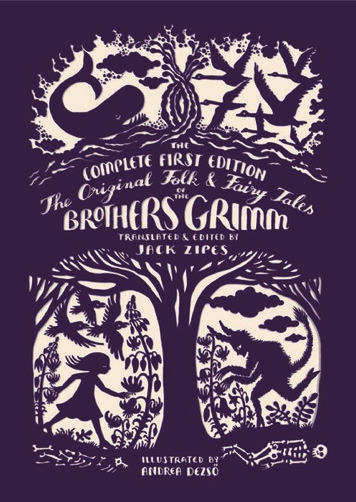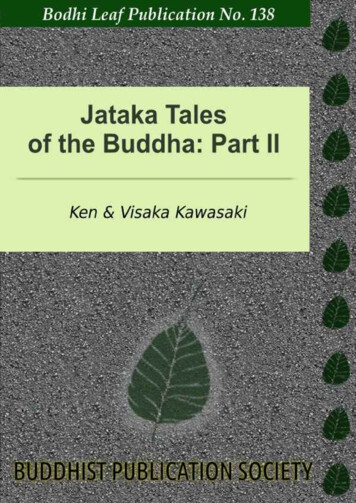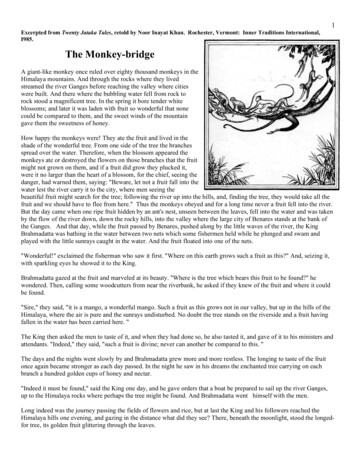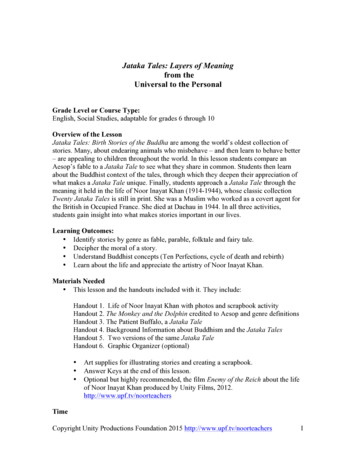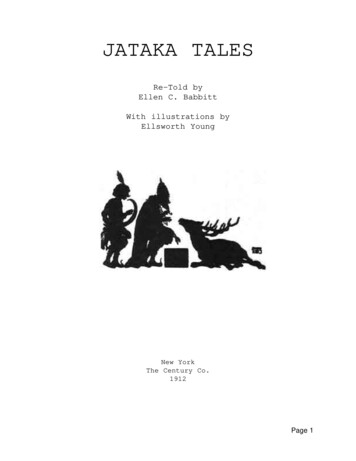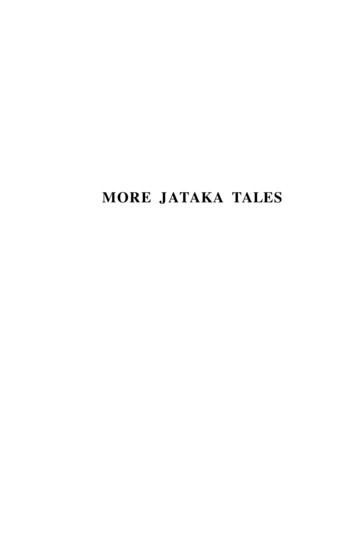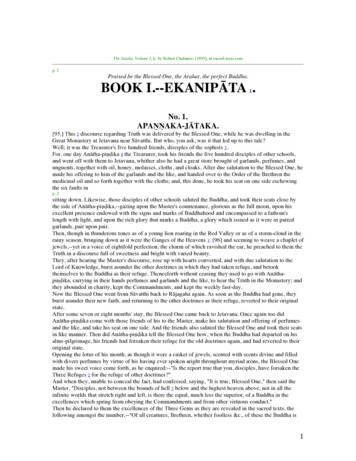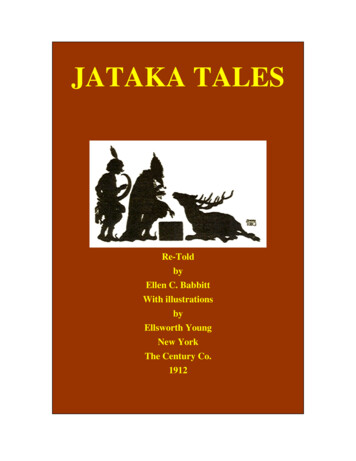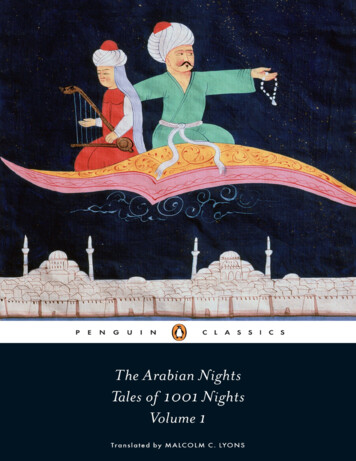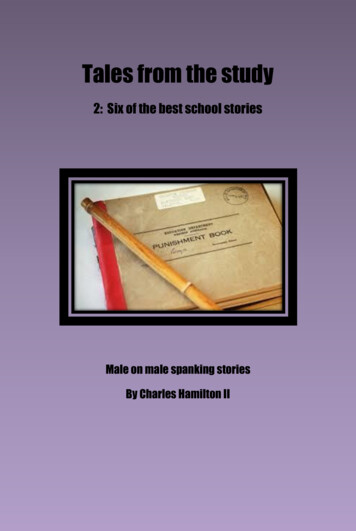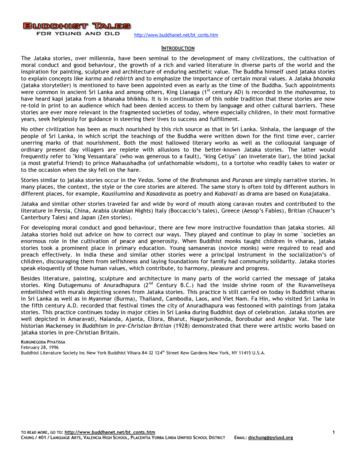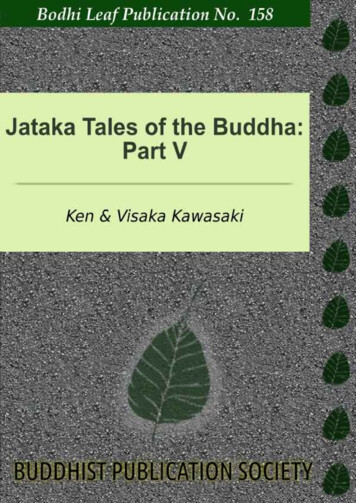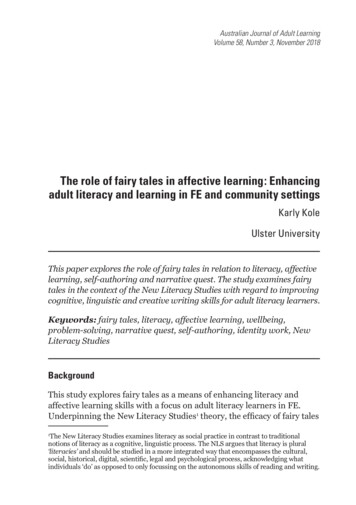
Transcription
Australian Journal of Adult LearningVolume 58, Number 3, November 2018The role of fairy tales in affective learning: Enhancingadult literacy and learning in FE and community settingsKarly KoleUlster UniversityThis paper explores the role of fairy tales in relation to literacy, affectivelearning, self-authoring and narrative quest. The study examines fairytales in the context of the New Literacy Studies with regard to improvingcognitive, linguistic and creative writing skills for adult literacy learners.Keywords: fairy tales, literacy, affective learning, wellbeing,problem-solving, narrative quest, self-authoring, identity work, NewLiteracy StudiesBackgroundThis study explores fairy tales as a means of enhancing literacy andaffective learning skills with a focus on adult literacy learners in FE.Underpinning the New Literacy Studies1 theory, the efficacy of fairy tales1The New Literacy Studies examines literacy as social practice in contrast to traditionalnotions of literacy as a cognitive, linguistic process. The NLS argues that literacy is plural‘literacies’ and should be studied in a more integrated way that encompasses the cultural,social, historical, digital, scientific, legal and psychological process, acknowledging whatindividuals ‘do’ as opposed to only focussing on the autonomous skills of reading and writing.
366 Karly Koleis demonstrated through oral storytelling, creative writing, role-play anddrama (Kole, 2017, pp. 11–13). A programme of work was designed anddelivered to include written assignments, questionnaires and case studyinterviews, where participants progress from a literal understanding ofnarrative text, to symbolic understanding of plot, character, figurativelanguage and a final creative writing piece on a fairy tale of choice.Existing as liminal narratives, fairy tales provide a unique structurewhere duality, conflict and transformation can be examined through selfauthoring, identity work and problem-solving. Fairy tales address themesin relation to power, gender, socio-economics and confront the impact ofthese issues regarding society, communities and individuals. Their multilayered aspects can also act as a unique construct for interdisciplinarylearning between literacy skills and personal social wellbeing.The multidimensional nature of fairy tales makes them an ideal vehiclefor exploring literacy in terms of linguistic and cognitive learning. Fairytales naturally reflect the hero narrative quest, wherein the character ischallenged, endures conflict, takes action and achieves his/her goal. Inthis context, fairy tales support the learner in finding new methods ofresolving challenges and transforming issues in their everyday lives.This approach is relevant to the implementation of the SustainableDevelopment Goals (SDGs) insofar as it indicates how adult literacylearning can contribute to a much broader range of interpersonalcapacities and their social application. The underlying attention topower relations has implications for learners in that it can enhance theirresourcefulness in engaging with a broader change process.Literacy singular, plural, ideological and autonomousAs the study explores fairy tales in the context of the New LiteracyStudies (NLS), it also proposes arguments in terms of contrastingideological and autonomous, singular and plural, vernacular anddominant literacies, as well as examining different learning practices interms of linguistic, cognitive and social affective learning.Previously educationists assumed that literacy was a single or unitary‘thing where writers often refer to a single ‘literacy’ and assume readerswill recognise this (Lambirth, 2005). Lambirth provides severalexamples of this unproblematic use of the term from various writers,
The role of fairy tales in affective learning 367discussing assessment of ‘literacy’, the success of a ‘literacy’ campaign,the challenge of teaching ‘literacy’ and how scholars work in early‘literacy’. In all these examples the singular term is used whereas, froma socio-cultural view, literacy is seen not as a singular thing but in theplural as ‘literacies’ (Lankshear & Knobel, 2011).Scribner and Cole (1981) provide a persuasive argument that ‘literacies’in the plural comprise contextual practices that people ‘engage’ in ratherthan skills that they apply. In particular, the work of Street (1984) hascontributed to an understanding of the notion of multiple literaciesconstructed in particular contexts and situations.These literacies according to Street are routines that people engage inat home, socially or through their work or learning environment. Street(1984) contributed to a view of literacy as a plural concept and alsocoined two terms: ‘ideological’ and ‘autonomous’ literacy. Street’s (1984)study ‘initiated a paradigmatic revolution’, which counteracted a skillsbased notion of literacy (Bartlett & Holland, 2002, p. 11) by arguing thatliteracy is always embedded within social institutions and is bound bypolitical, cultural and historical contexts.The term ‘ideological’ (Street 1984) refers to the interactions of poweraround reading and writing and the term ‘autonomous’ refers to a viewin which literacy is seen as a unitary concept, without reference tocontexts. An autonomous view works from the assumption that literacywill affect individual cognition and success in the world leading, forexample, to an improved economic position (Street, 2005). Accordingto Street (1984) there are assumptions in the autonomous modelpresented, as if the views are neutral and taken-for-granted.Street (1984) argues that we need to reconceptualise literacy asan ideological construct rather than an autonomous skill. This reconceptualisation of the notion of literacy is one of the key reasons whya socio-cultural research approach is significant. From a social practiceperspective therefore this research acknowledges the challenges of askills-based literacy standpoint and suggests that ‘autonomous’ viewsof literacy continue to dominate institutional educational practices,imposing conceptions of literacy. In this study therefore a broaderunderstanding of literacy practices is underpinned through social andcultural contexts moving beyond an autonomous conception of literacyas a neutral and technical skill.
368 Karly KoleNew Literacy Studies and identity workAccording to Gee (2012) the way we behave, interact, think, value, believe,speak and write are accepted as examples of performing particularidentities. This notion of performing identity was also emphasised byMoje and Luke who cited Norton and Toohey (2009, p. 415):When a language learner writes a poem, a letter, or an academicessay, he/she considers not only the demands of the task buthow much of his/her history will be considered relevant to thisliteracy act.Language learning engages the identities of learners because languageitself is not only a linguistic system of signs and symbols; it is also acomplex social practice in which the value and meaning ascribed to anutterance, are determined in part by the value and meaning ascribed tothe person who speaks.Norton and Toohey’s (ibid) quotation emphasises the idea of productionof identity through literacy practices or literacy practices as a way ofexploring identity. Identity is seen as not only multiple and malleablebut is also about an individual taking an ‘active’ part in producing andperforming their own identities to influence their social world. From thisposition, according to Greenhow, Robelia and Hughes (2009, pp. 123–4)identity is:dynamic, self-reflective and performative, rather than somethingthat just is, or that we develop into and sustain.This study therefore supports these theories with participants exploringidentity work and self-authoring through discussion, interviews andwritten assignments in the context of fairy tales underpinning the linksbetween language learning and identity (Kole, 2017, pp. 269–281).As these writers suggested, there is an ongoing process of activeproduction and mediation of identity even though the possibilitiesof authoring are bounded by constraints and the need to draw onexisting experiences.Drawing on a number of theoretical traditions, Moje et al. (2009)argue that the concept of identity is an active one focussed on themetaphor of identity as narrative. Moje suggested that this metaphor
The role of fairy tales in affective learning 369is a prominent one with theorists who have argued that identities arenot only represented but are constructed in and through stories. Whatis particularly significant here is the notion of the narrative productionof identity at ‘two’ levels. Moje et al (ibid) argue that people ‘narrate’stories and also ‘perform’ their identity concurrently. The context andinteraction with the audience are as significant as the narrative itself.Pahl and Rowsell (2012) having examined the active nature of literacyand identity through the New Literacy Studies (NLS) argue that ideasabout identity are central to research and theory in this field. Theyemphasise that an important idea in the NLS, is a shift from viewingidentities as individually produced, to viewing identities as ‘in practice’(Pahl & Rowsell, 2012). The authors note that not only do we expressidentity through language but also:through our dress, our artefacts, our web presence, etc. in otherwords, we create our identity through our social practices(Pahl & Rowsell, 2012, p. 114)Many studies have focussed on the notion of literacy identities inpractice, examples include research focussed on digital literacyand identity (Merchant 2005; 2006; Davies & Tatar, 2012), studiescomparing the disjuncture between schools and everyday literacies(Moje, Ciechanowski & Kramer, 2004) and studies in classrooms (Hirst,2004; Leander, 2002).In addition, Pahl and Rowsell (2007) introduced the notion of‘sedimented identities’ in relation to literacy practices, for example,where the social, economic and historical experiences are viewed aspart of the learner’s identity and therefore part of the literacy learningprocess. This notion can also be applied to artefacts or narratives andemphasises the multi-faceted complexity of identity work and literacy inthe NLS tradition.McCarthey and Moje (2002) explain how available literacy practicescan constrain and undermine identities, as well as providing chances toacquire new identities. The emphasis on active production of identityhas led to the use of the term ‘identity work’ in many studies Bartlett(2005), Merchant (2005) and Comber and Nixon (2004). This studytherefore integrates these theories underpinning identity as a sociallysituated practice.
370 Karly KoleNew Literacy Studies (NLS) fairy tales and space–timeMultimodal literacies have thus become a current focus through shiftsfrom written to visual texts (Pahl & Rowsell, 2010) with digital literacy,electronic texts and media technology environments dominating literacypractices (Merchant, 2009). As theories have diversified there has beenan expansion in NLS research particularly on ideas about space or placeand how these aspects interact with literacies (Leander & Sheehy, 2004).Space and place help to create human identities (Scollon & Scollon,2003) and where literacy practices take place can allow for morenuanced perspectives of meaning-making, for example, a literacy classset in a community hall would provide a different learning experienceto one delivered in a formal classroom setting. Space is generallyseen as a more abstract concept than place, although Cresswell(2004) acknowledged that people use the terms ‘space’ and ‘place’interchangeably. Theorisations about literacy and space have beenresearched and include investigations of classroom spaces, (Leander& Sheehy 2004; Clark, 2010; Burnett, 2011) and online, off-line spaces(Leander & McKim, 2003).Literacy events help to generate the nature and quality of space, whichalso includes physical, intellectual, social and emotional space as all ofthese aspects are essential for supporting learning (Kole, 2017, pp. 200–207). Rowe (2008) a socio-cultural scholar interested in the interfaceof space and literacy practices draws on Le Febvre’s work to argue thatspatial and material situations, shape literacy events. Rowe argues thatwriting and reading events in a library, for instance, may take a differentform from those happening in a different social environment.Literacy practices including values, social situations, physical objectsand spaces are discussed in Rowe (2008) underpinning their sociocultural viewpoint. As material space shapes literacy practices, spatialanalysis is therefore required to understand the way human beingscoordinate and are coordinated (Gee, 2001).During interviews for this study, photographs and objects were broughtto interviews by participants, as artefacts that supported their currentand past memories of literacy events. This reflected the socio-economicand historic events of participants’ literacy lives, highlighting the NLSfocusses on time–space dimensions where time can also be viewed as an
The role of fairy tales in affective learning 371intrinsic part of literacy practices (Kole, 2017, pp. 295–319). The designof case study interviews for this study was influenced by the material,spatial and embodied aspects of literacy practices with a focus onidentities illuminating the multi-faceted nature of participants’ literacyexperiences and the complexity of both narrating and performing storiesgrounded in identity work (Kole, 2017, pp. 200–207).According to Compton-Lilly (2008) we draw on past experience toaccount for the present and to project into the future. Compton’s workdrew on Lemke (2001) who used timescales to explain how identitydevelops longitudinally. Lemke similarly argued that identity formationcannot happen over short time spans and challenged views of time aslinear and forward moving. Instead, Lemke suggested we experiencetime as recursive, for example, we embed experiences from the pastinto the present. In particular, past experiences are then responsible fortaken-for-granted views.Some scholars have drawn on the notion of ‘time–space’ or ‘space–time’(Leander, 2001) and considered time and space to be inseparable andinterrelated. Leander and McKim (2003) explored space as fluid andmultiple, linked to time dimensions, drawing on multiple resourcesrelated to power and agency. In their view, possibilities always exist forchange and reconstruction because of the focus on space–time.Burgess (2010) discussed educational contexts in relation to time andspace, noting that the context is not bounded but includes connectionsto other spaces and times, therefore from this viewpoint, time and spaceare interlinked and socially produced.Fairy tales, chronotopes and New Literacy StudiesIn order to examine literacies as a social practice in the context of fairytales, this study has drawn on the nature of chronotopes (Bakhtin, 1981)and notion of timescales (Lemke, 2001) (Kole, 2017, pp. 156–160).Time–space concepts have helped to highlight how literacies arepositioned amongst shifting practices and connect in multiple ways toother contexts across times and locations.The concept of the chronotope literally means ‘time–space’ argued inBakhtin (1981) where notions of time and space made narrative eventsconcrete and define chronotopes as ‘the intrinsic connectedness of
372 Karly Koletemporal and spatial relationships that are artistically expressed inliterature’. In ‘Dialogic Imagination’ Bakhtin analysed novel genres andthe role chronotopes play in each genre. Bakhtin described the ancientadventure novel which contains what he terms ‘adventure time’ whichmakes no references to everyday aspects of time. In adventure timethe hero moves through time and space drawing on significant objectstowards a destination (1981, p. 84).Bakhtin discussed chronotopes in the context of literary criticism,the concept of chronotopes has been applied across other disciplines,within educational research in the NLS tradition. Hirst (2004) drewon chronotopes to analyse the role that temporal and spatial practicesplayed in determining power relations in a particular classroom in whichglobal relations and social identities intermingled.Van Enk (2007) used chronotopes as a tool for analysing how adultlearners’ relationships to literacy are accounted for in often inferredconceptions of time and space. Van Enk noted that through this lens,narratives can be analysed in terms of what they suggest about howthings might have been or might yet be different.As NLS is rooted in research, as well as practice, it implies a teachingmethod that facilitates students and teachers alike, helping them todescribe, observe and analyse different literacies, rather than learningand teaching one literacy as given. In Heath’s terms (1983) teachersand students therefore become ‘ethnographers’ exploring variousmeanings and uses of literacy in the social context of both school andthe surrounding communities where ‘schooled literacy’ becomes one,amongst many of the literacies with which they engage.Street (1997) indicates therefore that the task to be developed is a twofold approach: to challenge the dominant representations of literacy;and to develop collaborative research projects that look at the actualliteracy practices of community, home and school with a view asFreebody (1995) states to ‘effective mutual recognition of these practicesin all sites’ and for the data thus collected to be fed into teacher trainingprogrammes, curricula and pedagogy. The practical consequences andchallenges for educationalists in recognising these principles argued inStreet’s debate on the NLS, where he proposes a checklist of principleson which its application to education would be based about curriculum,pedagogy and assessment (1997, p. 8):
The role of fairy tales in affective learning 373 Literacy is more complex than curriculum assessment allowswhere the curricula and assessment reduce literacy to a fewsimple and mechanistic skills, fail to do justice to the richnessand complexity of actual literacy practices in people’s lives. If we want learners to develop and enhance the richness andcomplexity of literacy practices evident in society at large,then we need curricula and assessment that are themselvesrich and complex and based upon research into actualliteracy practices. To develop rich and complex curricula and assessment ofliteracy we need models of literacy and of pedagogy thatcapture the richness and complexity of actual literacy practicesParticipants and materialsIn investigating the literacy lives of a group of adult literacy learners,the study drew on the theoretical traditions associated with the NLSparadigm, applying this within the context of fairy tales (Kole, 2017, pp.156–160). The participants were adult literacy learners recruited throughan FE college. Literacy learning support was offered to the participantsas part of a study on creative writing to enhance literacy and wellbeingthrough the narrative quest of fairy tales. Seventeen participants signedup for the study, which was conducted over a five-month period. Thestudy included a mixed age, ability and gender group. Workshopswere held once a week for a two-hour duration session, which involvedtraditional oral story telling through fairy tales, group discussion, writtenassignments, drama, role-play and case study interviews.Participants were initially assessed on their literacy levels throughBSKB2 diagnostic assessment tests. The scores from these tests thendetermined what participants’ current literacy status was, in terms ofeither level 1 or level 2 literacy standard. All participants were workingtowards a level 2 literacy qualification. Additionally assessment was alsoconducted through the Outcome star programme (2009–2015), whichidentified social exclusion indicators.2BSKB (Basic Key Skills Builder) is an online assessment tool that provides an initi
problem-solving, narrative quest, self-authoring, identity work, New Literacy Studies Background This study explores fairy tales as a means of enhancing literacy and affective learning skills with a focus on adult literacy learners in FE. Underpinning the
